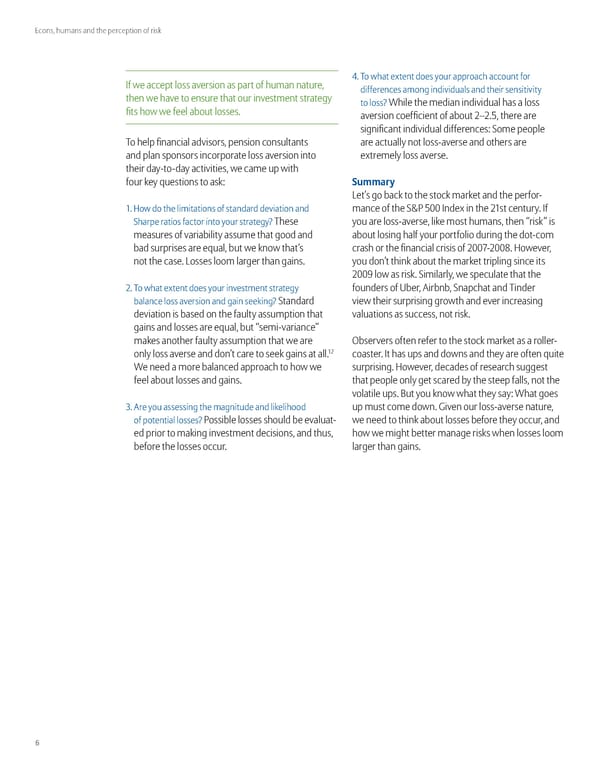Econs, humans and the perception of risk „f we accept loss aversion as part of human nature, §. Žo what etent does your approach account for then we have to ensure that our investment strategy differences among individuals and their sensitivity fits how we feel about losses. to loss˜ •hile the median individual has a loss aversion coefficient of about …–….ƒ, there are significant individual differences” ome people Žo help financial advisors, pension consultants are actually not lossaverse and others are and plan sponsors incorporate loss aversion into etremely loss averse. their daytoday activities, we came up with four key “uestions to ask” Summary ›et’s go back to the stock market and the perfor . ¬ow do the limitations of standard deviation and mance of the €‚ ƒ „nde in the …st century. „f harpe ratios factor into your strategy˜ Žhese you are lossaverse, like most humans, then “risk” is measures of variability assume that good and about losing half your portfolio during the dotcom bad surprises are e“ual, but we know that’s crash or the financial crisis of … †… ‰. ¬owever, not the case. ›osses loom larger than gains. you don’t think about the market tripling since its … low as risk. imilarly, we speculate that the …. Žo what etent does your investment strategy founders of Uber, Œirbnb, napchat and Žinder balance loss aversion and gain seeking˜ tandard view their surprising growth and ever increasing deviation is based on the faulty assumption that valuations as success, not risk. gains and losses are e“ual, but “semivariance” makes another faulty assumption that we are Observers often refer to the stock market as a roller … only loss averse and don’t care to seek gains at all. coaster. „t has ups and downs and they are often “uite •e need a more balanced approach to how we surprising. ¬owever, decades of research suggest feel about losses and gains. that people only get scared by the steep falls, not the volatile ups. œut you know what they say” •hat goes £. Œre you assessing the magnitude and likelihood up must come down. ‘iven our lossaverse nature, of potential losses˜ ‚ossible losses should be evaluat we need to think about losses before they occur, and ed prior to making investment decisions, and thus, how we might better manage risks when losses loom before the losses occur. larger than gains.
 Econs, Humans, and the Perception of Risk Page 5 Page 7
Econs, Humans, and the Perception of Risk Page 5 Page 7